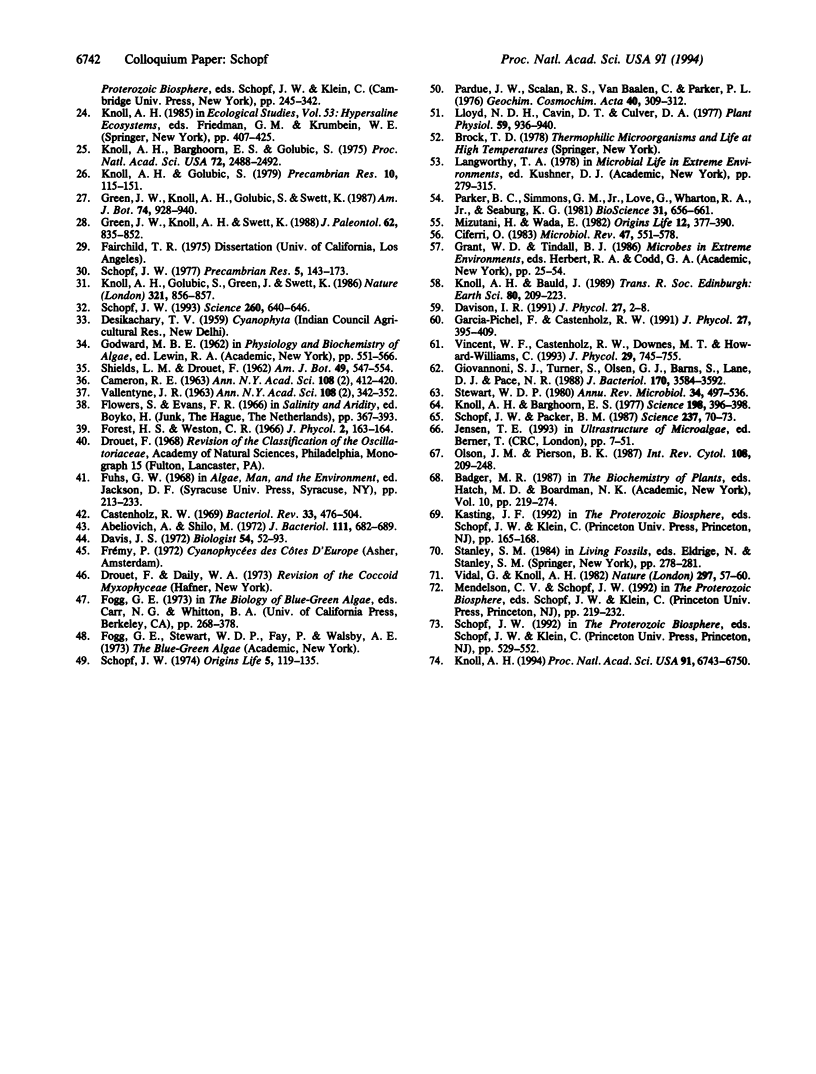Abstract
Over the past quarter century, detailed genus- and species-level similarities in cellular morphology between described taxa of Precambrian microfossils and extant cyanobacteria have been noted and regarded as biologically and taxonomically significant by numerous workers world-wide. Such similarities are particularly well documented for members of the Oscillatoriaceae and Chroococcaceae, the two most abundant and widespread Precambrian cyanobacterial families. For species of two additional families, the Entophysalidaceae and Pleurocapsaceae, species-level morphologic similarities are supported by in-depth fossil-modern comparisons of environment, taphonomy, development, and behavior. Morphologically and probably physiologically as well, such cyanobacterial "living fossils" have exhibited an extraordinarily slow (hypobradytelic) rate of evolutionary change, evidently a result of the broad ecologic tolerance characteristic of many members of the group and a striking example of G. G. Simpson's [Simpson, G.G. (1944) Tempo and Mode in Evolution (Columbia Univ. Press, New York)] "rule of the survival of the relatively unspecialized." In both tempo and mode of evolution, much of the Precambrian history of life--that dominated by microscopic cyanobacteria and related prokaryotes--appears to have differed markedly from the more recent Phanerozoic evolution megascopic, horotelic, adaptationally specialized eukaryotes.
Full text
PDF







Images in this article
Selected References
These references are in PubMed. This may not be the complete list of references from this article.
- Abeliovich A., Shilo M. Photooxidative death in blue-green algae. J Bacteriol. 1972 Sep;111(3):682–689. doi: 10.1128/jb.111.3.682-689.1972. [DOI] [PMC free article] [PubMed] [Google Scholar]
- CAMERON R. E. Morphology of representative blue-green algae. Ann N Y Acad Sci. 1963 Jun 29;108:412–420. doi: 10.1111/j.1749-6632.1963.tb13395.x. [DOI] [PubMed] [Google Scholar]
- Campbell S. E. Soil stabilization by a prokaryotic desert crust: implications for Precambrian land biota. Orig Life. 1979 Sep;9(4):335–348. doi: 10.1007/BF00926826. [DOI] [PubMed] [Google Scholar]
- Castenholz R. W. Thermophilic blue-green algae and the thermal environment. Bacteriol Rev. 1969 Dec;33(4):476–504. doi: 10.1128/br.33.4.476-504.1969. [DOI] [PMC free article] [PubMed] [Google Scholar]
- Ciferri O. Spirulina, the edible microorganism. Microbiol Rev. 1983 Dec;47(4):551–578. doi: 10.1128/mr.47.4.551-578.1983. [DOI] [PMC free article] [PubMed] [Google Scholar]
- Giovannoni S. J., Turner S., Olsen G. J., Barns S., Lane D. J., Pace N. R. Evolutionary relationships among cyanobacteria and green chloroplasts. J Bacteriol. 1988 Aug;170(8):3584–3592. doi: 10.1128/jb.170.8.3584-3592.1988. [DOI] [PMC free article] [PubMed] [Google Scholar]
- Green J. W., Knoll A. H., Golubic S., Swett K. Paleobiology of distinctive benthic microfossils from the upper Proterozoic Limestone-Dolomite "Series," central East Greenland. Am J Bot. 1987;74(6):928–940. [PubMed] [Google Scholar]
- Green J. W., Knoll A. H., Swett K. Microfossils from oolites and pisolites of the Upper Proterozoic Eleonore Bay Group, Central East Greenland. J Paleontol. 1988;62(6):835–852. doi: 10.1017/s0022336000030109. [DOI] [PubMed] [Google Scholar]
- Knoll A. H., Barghoorn E. S. Archean microfossils showing cell division from the swaziland system of South Africa. Science. 1977 Oct 28;198(4315):396–398. doi: 10.1126/science.198.4315.396. [DOI] [PubMed] [Google Scholar]
- Knoll A. H., Barghoorn E. S., Golubić S. Paleopleurocapsa wopfnerii gen. et sp. nov.: A Late Precambrian alga and its modern counterpart. Proc Natl Acad Sci U S A. 1975 Jul;72(7):2488–2492. doi: 10.1073/pnas.72.7.2488. [DOI] [PMC free article] [PubMed] [Google Scholar]
- Knoll A. H., Bauld J. The evolution of ecological tolerance in prokaryotes. Trans R Soc Edinb Earth Sci. 1989;80:209–223. doi: 10.1017/s0263593300028650. [DOI] [PubMed] [Google Scholar]
- Knoll A. H., Golubic S., Green J., Swett K. Organically preserved microbial endoliths from the late Proterozoic of East Greenland. Nature. 1986 Jun 26;321(6073):856–857. doi: 10.1038/321856a0. [DOI] [PubMed] [Google Scholar]
- Knoll A. H. Proterozoic and early Cambrian protists: evidence for accelerating evolutionary tempo. Proc Natl Acad Sci U S A. 1994 Jul 19;91(15):6743–6750. doi: 10.1073/pnas.91.15.6743. [DOI] [PMC free article] [PubMed] [Google Scholar]
- Lloyd N. D., Canvin D. T., Culver D. A. Photosynthesis and photorespiration in algae. Plant Physiol. 1977 May;59(5):936–940. doi: 10.1104/pp.59.5.936. [DOI] [PMC free article] [PubMed] [Google Scholar]
- Olson J. M., Pierson B. K. Evolution of reaction centers in photosynthetic prokaryotes. Int Rev Cytol. 1987;108:209–248. doi: 10.1016/s0074-7696(08)61439-4. [DOI] [PubMed] [Google Scholar]
- Ruedemann R. Additional Studies in Arrested Evolution. Proc Natl Acad Sci U S A. 1922 Mar;8(3):54–55. doi: 10.1073/pnas.8.3.54. [DOI] [PMC free article] [PubMed] [Google Scholar]
- Schopf J. W. Microfossils of the Early Archean Apex chert: new evidence of the antiquity of life. Science. 1993 Apr 30;260:640–646. doi: 10.1126/science.260.5108.640. [DOI] [PubMed] [Google Scholar]
- Schopf J. W., Packer B. M. Early Archean (3.3-billion to 3.5-billion-year-old) microfossils from Warrawoona Group, Australia. Science. 1987 Jul 3;237:70–73. doi: 10.1126/science.11539686. [DOI] [PubMed] [Google Scholar]
- Schopf J. W. The development and diversification of Precambrian life. Orig Life. 1974 Jan-Apr;5(1):119–135. [PubMed] [Google Scholar]
- Schopf J. W. The evolution of the earliest cells. Sci Am. 1978 Sep;239(3):110-2, 114, 116-20 passim. doi: 10.1038/scientificamerican0978-110. [DOI] [PubMed] [Google Scholar]
- Stewart W. D. Some aspects of structure and function in N2-fixing cyanobacteria. Annu Rev Microbiol. 1980;34:497–536. doi: 10.1146/annurev.mi.34.100180.002433. [DOI] [PubMed] [Google Scholar]
- VALLENTYNE J. R. Environmental biophysics and microbial ubiquity. Ann N Y Acad Sci. 1963 Jun 29;108:342–352. doi: 10.1111/j.1749-6632.1963.tb13387.x. [DOI] [PubMed] [Google Scholar]





